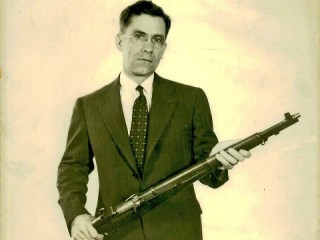John C. Garand was born in Canada, and came to America with his father after his mother's death, when he was about eleven years old. Speaking little English but fluent French, he quit school and went to work at a textile mill to help support his family, and later he became a machinist at a precision tool factory. Always a gun enthusiast, he took correspondence courses in engineering, and designed his first machine gun in 1917. He submitted it to the US military and while it was not accepted for manufacture, it was deemed impressive enough that he was hired by the National Bureau of Standards (now the National Institute of Standards and Technology) to refine its design. In 1919 he was transferred as a civilian employee to the Army Ordnance Department, and assigned to the Army arsenal in Springfield, Massachusetts (where the Springfield rifle had been developed). There Garand spent the next seventeen years designing a weapon to replace the reliable but difficult-to-master Springfield. He engineered a 30-caliber, 8-shot, slip-loading weapon which could fire four times as many shots as the Springfield rifle, with far less recoil. This made the M-1 semiautomatic or Garand rifle an ideal weapon for the battlefields of World War II, where it was standard-issue for American troops and a key factor in the allied victory.
A naturalized citizen driven by patriotism, Garand signed his patents over to the US government, and never received financial compensation beyond his ordinary wages. At a ceremony marking his retirement in 1953, he was presented with the one-millionth Garand rifle. Production continued until 1957, and over 5,000,000 Garand rifles were manufactured.



















